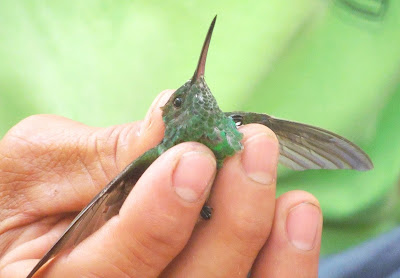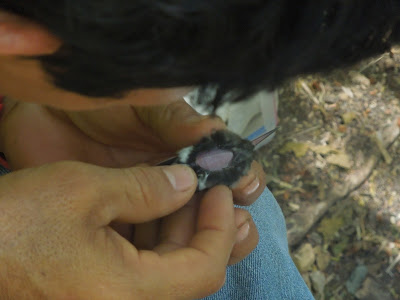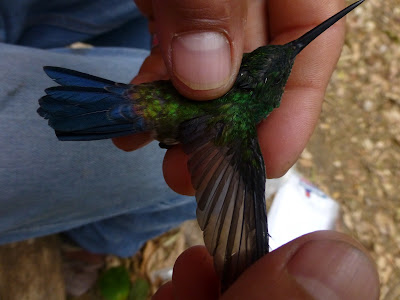There are lots of interesting and important bird studies to be performed in Nicaragua, among them, issues regarding hummingbirds. What habitats
hummingbirds prefer, and how human land use impacts each hummingbird species can be an important issue for Nicaragua, especially now that Nicaragua is developing rapidly. To make such analyses, however, identification of the hummingbirds is vital, but not always straightforward. Both the Blue-tailed hummingbird,
Amazilia cyanura, and the Steely-vented Hummingbird,
Amazilia saucerrottei, are reported for Nicaragua, although they are so similar that we don't trust any distinctions made in reports about them.
Conservation science intern Bart Verdijck has been examining the populations of the species in Laguna de Apoyo Nature Reserve, to determine which is here and whether any distinctions can be made in the field, where supposedly, the two species occur together.
 |
| This hummingbird is lending us a few minutes of his time to further the knowledge about his species. Is he a Blue-tailed Hummingird (Amazilia cyanura) or a Steely-vented Hummingbird (Amazilia saucerrottei)? Photo Bart Verdijck. |
Ten hummingbird species have been recorded in
Laguna de Apoyo Nature Reserve to date. Some species are quite rare or even accidental, whereas others are very common. These two species, however, intrigue one in a special way, because little information exists on the two species in the same place.
 |
| FUNDECI/GAIA technician Elmer Nicaragua holds a hummingbird. Photo Bart Verdijck. |
The intense urbanization all through the region means that hummingbird habitats are being altered rapidly. Without knowing what resources are required for year-round sustenance and reproduction of each species, we are gambling against the hummingbirds with every new forest cleared, building constructed, and parking lot paved. Which hummingbirds among the great diversity of the region will be lost?
 |
| Hummingbirds are easily captured by mist nets for study. Photo Bart Verdijck. |
The overlapping ranges of
A. cyanura and
A. saucerrottei mean that resources upon which the two species depend must be divided somehow. Our first goal is to compare the
abundances of these and other hummingbirds in each of several sites in Laguna de Apoyo Nature Reserve, to look for trends according to forest structures and land use patterns.
 |
| Elmer examines the tail and wing colors on this hummingbird. Photo Bart Verdijck. |
In addition to comparing
A. cyanura and
A. saucerrottei habitat preferences and abundances in Laguna de Apoyo Nature Reserve through analysis of mist netting data, Bart is examining the populations of all the hummingbirds, using both mist netting and point count results.
 |
| Undertail coverts showing the characteristic pattern of the Steely-vented Hummingbird. Photo Bart Verdijck. |
Among the trends hopefully found in the analysis are patterns of reproductive activity. When birds are captured through mist netting, nesting can be inferred from examination of the brood patch which many bird species have-a bare section on the belly, which is highly vascularized and swollen to transfer warmth to eggs, when the birds are sitting.
 |
| Examination of the brood patch can demonstrate whether a bird is nesting. Photo Bart Verdijck. |
 |
| This hummingbird shows a wet head after our technicians examined the ossification on its cranium. Photo Bart Verdijck. |
 |
| Now that this bird has been examined and measured, it is ready to return to the wild. Photo Bart Verdijck. |
Some hummingbirds migrate, most notably the Ruby-throated Hummingbird which nests in North America and can be found in Nicaragua during the cold months in its nesting range. Other hummingbirds also migrate, particularly the Blue-tailed Hummingbird, as folks learned in a study in northern Nicaragua. Elevational migrations toward the end of the dry season may be necessary for many birds in tropical dry forest to survive the last weeks of the period, when food items may disappear.
 |
| The vent of this bird has the characteristic pattern of the Steely-vented Hummingbird. Photo Bart Verdijck. |
Laguna de Apoyo Nature Reserve is very small-only 4300 hectares, of which almost half is water. Knowledge of migratory patterns is vital to protecting the species found in this reserve.
 |
| The red coloration on the lower mandible terminates before the tip. Photo Bart Verdijck. |
 |
Lacking evident rusty secondary covert feathers (these are bronzy green) demonstrates that this bird is a Steely-vented Hummingbird (Amazilia saucerrottei). Photo Barth Verdijck.
Helping Nicaragua protect its native fauna in the face of rapid development is our challenge. FUNDECI/GAIA is dedicated to protecting wild nature in Nicaragua in harmony with its people. If you would like to work alongside Nicaraguans and visitors from other countries as a volunteer or intern, you are welcome to participate. Hummingbirds and many other species of animals are waiting for your help!
 |
| Click on the "escudo" to contact us. |
|












No comments:
Post a Comment